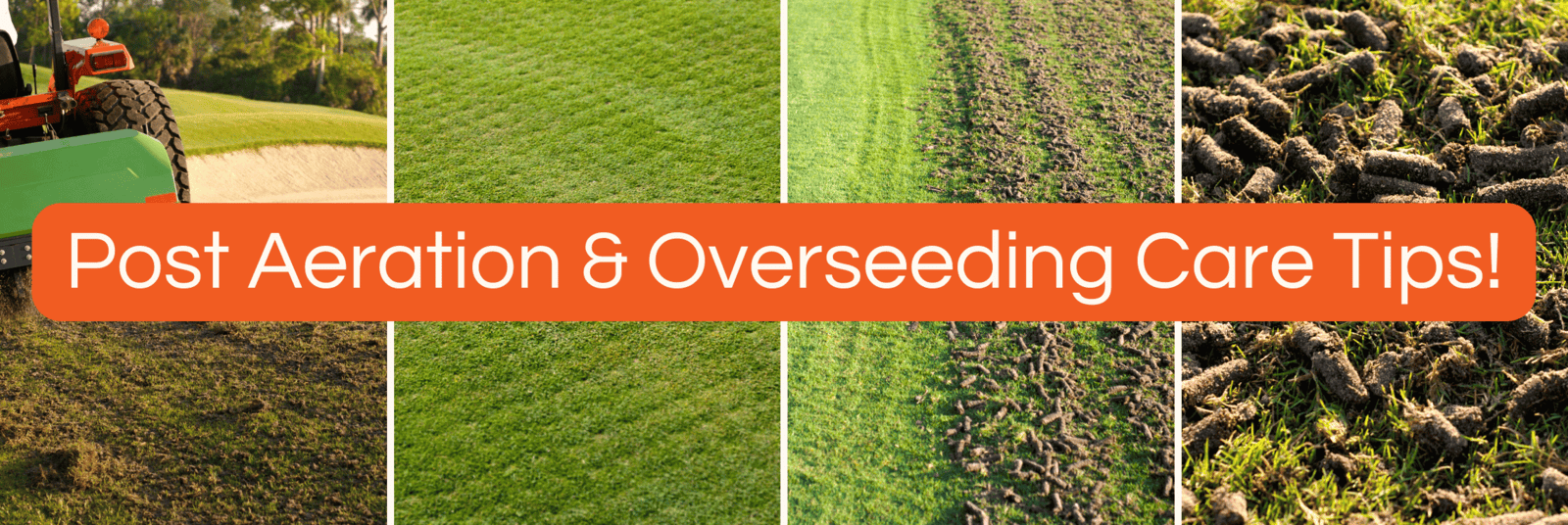Aeration and overseeding are two crucial lawn care practices that rejuvenate your lawn and prepare it for optimal growth. After investing in these treatments, it’s essential to follow the proper post-care steps to help your lawn recover, establish new growth, and thrive for the long term. Below are key tips to ensure your aerated and overseeded lawn receives the care it needs to flourish.

1. Watering: Gentle and Consistent Hydration
1. Watering: Gentle and Consistent Hydration
Proper watering is vital for newly overseeded grass. Without consistent moisture, seeds may dry out, preventing germination. Here’s how to water your lawn effectively after aeration and overseeding:
- First 2 Weeks: Water your lawn lightly and frequently. Aim to water once or twice a day to keep the topsoil consistently moist, but avoid saturating the lawn to the point of puddling. A light misting is often enough to keep seeds damp, especially in the early stages.
- Weeks 3-4: After the initial 2 weeks, you can reduce the watering frequency to every other day, but increase the watering duration. This encourages deeper root growth as the seedlings start to establish themselves.
- After 1 Month: Gradually transition to a typical watering schedule, watering your lawn deeply 2-3 times a week. A good rule of thumb is to aim for about 1 inch of water per week from rainfall or irrigation.
2. Mowing: Timing and Technique Matter
2. Mowing: Timing and Technique Matter
Mowing is necessary to keep your lawn healthy, but after overseeding, it's important to let the new grass grow and establish itself before cutting.
- Hold Off on Mowing: Refrain from mowing your lawn for at least 2-3 weeks after overseeding. The new seedlings need time to grow to about 3-4 inches in height before they are strong enough to handle mowing.
- First Mow: When it’s time to mow, set your mower to the highest setting. Only cut the top third of the grass to avoid stressing the young seedlings.
- Regular Mowing: Once the new grass is established, maintain regular mowing, but always keep the grass at least 3 inches tall. Taller grass promotes deeper roots and helps shade out weeds.
3. Fertilization: Boosting Growth the Right Way
3. Fertilization: Boosting Growth the Right Way
Fertilization plays an important role in providing the necessary nutrients for new grass growth, but timing is key.
- Use a Starter Fertilizer: TruScape may apply a starter fertilizer during overseeding to provide the essential nutrients your grass needs to grow. If not, you should apply one after overseeding to jumpstart growth.
- Avoid Immediate Fertilization: After overseeding, avoid heavy fertilization until the grass has been mowed 2-3 times. Applying fertilizer too early can overwhelm the young grass and may lead to nutrient burn.
- Seasonal Fertilization: Plan on fertilizing again in about 6-8 weeks after overseeding, using a balanced slow-release fertilizer to continue promoting growth. Regular fertilization during the growing season will help your lawn thrive.
4. Weed Control: Be Patient
4. Weed Control: Be Patient
It’s tempting to control weeds immediately after aeration and overseeding, but applying herbicides too soon can harm your new grass.
- Wait on Herbicides: Do not apply any weed control products for at least 6-8 weeks after overseeding. Herbicides can inhibit seed germination and damage new grass.
- Hand-Pull Weeds: If you notice any weeds, consider hand-pulling them during this time. Once your grass is established, you can safely apply a selective herbicide if necessary.
5. Traffic and Activity: Give Your Lawn a Break
5. Traffic and Activity: Give Your Lawn a Break
Your newly overseeded lawn is in a delicate state and needs time to establish itself without heavy foot traffic or stress.
- Minimize Foot Traffic: For the first few weeks, minimize walking or playing on the lawn. The new seedlings are fragile, and excessive foot traffic can damage them before they’ve had time to root properly.
- Avoid Heavy Equipment: Keep mowers, carts, or any heavy equipment off the lawn for at least 3-4 weeks. This prevents soil compaction and gives your grass the best chance to grow.
6. Pest Control: Keep an Eye on Your Lawn
6. Pest Control: Keep an Eye on Your Lawn
Aeration and overseeding can sometimes attract pests, such as birds, that feed on the grass seed. In addition, your lawn may be more susceptible to pests that can damage the delicate new grass.
- Watch for Birds: Birds may be attracted to the freshly laid seeds. If birds are becoming an issue, you can use bird netting or scare tactics like reflective objects to deter them.
- Monitor for Insects: Keep an eye on your lawn for any signs of insect damage, such as chewed leaves or brown spots. If pests become an issue, consult a lawn care professional to determine the safest way to treat your lawn without harming the new grass.
7. Patience is Key: Allow Time for Results
7. Patience is Key: Allow Time for Results
It’s important to manage your expectations and be patient with the overseeding process. The new grass will take time to establish fully, and you may not see immediate results.
- Germination Time: Depending on the grass type, it may take 7-21 days for the seeds to germinate. Cooler temperatures or dry conditions can extend this period.
- Full Lawn Coverage: It may take up to 6-8 weeks for your lawn to fully thicken and establish after overseeding. During this time, continue with your care routine to promote healthy growth.
Conclusion: Consistent Care for Long-Term Results
Conclusion: Consistent Care for Long-Term Results
Aeration and overseeding are powerful treatments to restore and improve the health of your lawn, but they require diligent post-care to achieve the best results. By following the watering, mowing, fertilization, and weed control tips outlined above, you’ll give your lawn the best chance to thrive and enjoy lush, healthy growth for years to come. If you need any guidance or additional services, TruScape is here to help you every step of the way.


